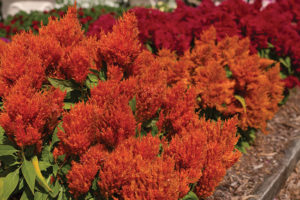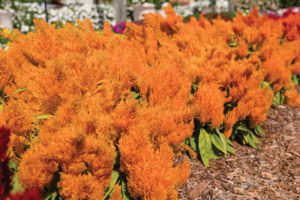
Culture Report: Flamma Celosia
When asked what the most important feature is for a plume-type celosia to have, almost all avid gardeners agree: flower color power that endures.
A PEDIGREE WITH PROMISE
Over the years, Sakata has introduced celosia lines that have taken place as “best in class” as well as individuals like Dragon’s Breath, standing alone to receive the illustrious title of “only in class.”
Having been recently introduced, and with members of the series already winning awards, the new All-America Selections (AAS) award winner Flamma celosia is no exception. The incredible size of Flamma’s robust plumes pair with its ability to hold color well past its peers. Sakata has continued to build on its reputation for high- quality celosia series, and Flamma is raising the bar higher.
WHERE FLAMMA FITS, AND WHY
Sitting right between Sakata’s current small- and large-plume celosia series, Flamma takes its place as an early flowering, medium-sized type-celosia. Sakata has made great strides in summer- produced plants that turn heads into the fall season, and Flamma spearheads this initiative with its exceptional heat tolerance. This series complements other summer staples that have longevity into autumn, like Profusion zinnia.
Like Sakata’s Century celosia series, Flamma is a facultative short-day plant, which begins flowering in early July after the summer solstice and lights up the landscape with abundant color as the day length naturally shortens.
This all sounds familiar when speaking on plume celosias, but here’s where Flamma sets itself atop the podium: color longevity. In pots as well as the flower bed, Flamma holds color across its series beyond all other commercial varieties, with the deep hues persisting well into the late days of the season.
STRONG STEMS AND SPACING
How Flamma supports such an arsenal of color is also in the magic of its genetics: strong vigor combined with tight internodes on the medium compact plants. This kind of stem architecture is designed to hold the large upper plumes while also promoting new branching and flowers from the base of the plant. The take home is this: big color built to withstand all types of weather.
Individual plants will range from about 14 to 18 inches in height and 8 to 12 inches in width. Recommended plant density is one plant per 4- to 5-inch pot, three plants per 8-inch pot and four plants per 10-inch pot. Space Flamma 12 to 14 inches on center in flower beds.
PALETTES OF PERFORMANCE

With uniform flower timing across the series, Flamma arrives to us with five colors and one mix, including a Red, Bright Red, Golden, Rose and Orange, a 2022 AAS award winner. The well-rounded color assortment provides exceptional beauty from mid-summer through the last days of autumn. Look for more color additions to this fantastic line in the seasons to come.
PROPAGATION NOTES
- Plug stage media pH should be 5.8 to 6.2.
- Germination temperature should be between 70 and 75° F.
- Roots are delicate, so plug trays are preferred over open flats.
- When seedlings emerge, ventilate well and drop temperatures to about 67° F day and 63° F night.
- Extend daylength to greater than 13 hours for plugs to avoidpremature flowering.
- Fertilize lightly with 50 to 100 ppm nitrogen, and maintain boron at 0.25 ppm to avoid a deficiency.
- It is a four-week time to transplant in a 288 tray.
- Seedlings are ready for transplant at the two to three leaf stage.
- Plug popper is preferred due to delicate roots.
- Handle by the leaves only to prevent stem damage.
- Avoid deep transplanting to prevent disease.
TRANSPLANT TO FINISH NOTES
- Avoid overfeeding to counteract salt stress.
-
- (0.9 to 1.3 mmhos/cm 1:2, 2.1 to 3.5 mmhos/cm SME, 2.7 to 4.6 mmhos/cm pour thru)
-
- Avoid temps below 61° F to promote active growth.
- Keep days longer than 13 hours to bulk plants and avoid early flowering.
- No PGRs needed. Do not pinch!
- Fertilize at 125 to 150 ppm N using 15-5-20 Pansy Special for sufficient potassium and boron.
- Do not drench with Mefenoxam (SubdueMaxx), which causes phytotoxicity.
- Recommended plant density is one plant per pot in quarts and 2.5 quarts; one plant per 4 and 5-inch pots; three plants per 8-inch pots; and four plants per 10-inch pots.
- Space in beds roughly 12 to 14 inches on center. • Total crop time ranges from eight weeks in jumbo packs to 10 weeks in 4 and 5-inch pots.











 Video Library
Video Library 


















